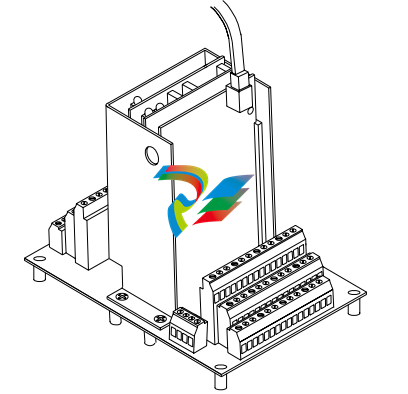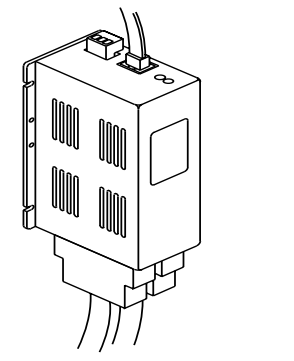
WATLOWMLS300 Series User’s Guide
input scaling resistors, if required. (RTDs, inputs greater than
60 mVdc, and mAdc current inputs require input scaling
resistors.) The AIM-TB has three slots for the plug-in AIM
cards.
There are two versions of the MLS300-AIM: the AIM-16 and
AIM-32. The AIM-16 has one multiplexer (MUX) card, and
the AIM-32 has two MUX cards. These cards multiplex the 16
inputs each card receives. Each -10 to 60 mVdc input is
converted to a voltage that is transmitted to the Voltage/
Frequency (V/F) card. (The MUX cards also automatically
calibrate the zero and span of the analog amplifier and
measure the cold junction compensation temperature for
thermocouple inputs.) Both the AIM-16 and AIM-32 have a
V/F card, which converts the input signal voltage to a
frequency. The converted signal is then transmitted via the
AIM cable to the MLS300-PM for processing.

The MLS300 Compact Input Module (CIM300) consists of
two circuit boards that perform analog-to-digital conversion
and data communications to the processor module. The
CIM300 receives input signals from sensors and transmits this
information to the MLS300-PM through the AIM cable.
The CIM300 includes power supply terminals, input signal
connectors, a communications connector and input signal
conditioning circuits. It also includes a cold-junction
temperature sensor and room for the input scaling resistors, if
required. (RTDs, inputs greater than 60 mV dc, and mA dc
current inputs require input scaling resistors.)
There are two versions of the CIM300: the CIM316 and
CIM332. The CIM316 supports 16 inputs through a D-Sub 50
female connector and the CIM332 supports 32 inputs through
2 D-Sub 50 connectors (inputs 1 to 16 female, inputs 17 to 32
male). The user supplies the mating D-Sub 50 connectors. The
CIM300 has one or two multiplexer circuits that multiplex the
16 inputs each card receives. Each -10 to 60 mV dc input is
converted to a voltage that is transmitted to the Voltage/
Frequency (V/F) card. (The mulitplexer circuits also
automatically calibrate the zero and span of the analog
amplifier and measure the cold-junction compensation
temperature for thermocouple (T/C) inputs.) A V/F circuit
converts the input signal voltage to a frequency. The
converted signal is then transmitted via the AIM cable to the
MLS300-PM for processing

MLS300 Cabling
Watlow Anafaze provides cables required to install your
MLS300.
A 50-pin SCSI cable connects the TB50 to the MLS300-PM.
The cable connecting the MLS300-PM to the AIM-TB is an
8-conductor, shielded cable with RJ-45 connectors.
The cables used to connect the MLS300 to EIA/RS-232 or
EIA/RS-485 communications are 6-conductor, shielded cable
with RJ-12 connectors on one end and a DB-9 connector or
bare wires on the other end.
The pin numbering convention used for communications cables varies between suppliers. See Serial Communications, Cable
Connector Pin Outs on page 62.
Safety
Watlow Anafaze has made every effort to ensure the
reliability and safety of this product. In addition, we have
provided recommendations that will allow you to safely
install and maintain this controller.
Ensure that power has been shut off to your
entire process before you begin installation
of the controller.
WARNING! In any application, failures can occur. These
failures can result in full control output (100%
power), or the occurrence of other output failures which can cause damage to the controller, or to the equipment or process
connected to the controller. Therefore, always follow good engineering practices,
electrical codes, and insurance regulations
when installing and operating this equipment.
External Safety Devices
External safety devices should be used to prevent potentially
dangerous and unsafe conditions upon equipment failure.
Always assume that this device can fail with outputs full-on,
or full-off, by the occurrence of an unexpected external
condition.
Always install high or low temperature protection in installations where an over-temperature or under-temperature fault will present
a potential hazard. Failure to install external
protection devices where hazards exist can
result in damage to equipment and property
as well as loss of human life.
Power-Fail Protection
In the occurrence of a sudden loss of power, this controller can
be programmed to reset the control outputs to OFF (this is the
default). Typically, when power is re-started, the controller
restarts to data stored in memory. If you have programmed the
controller to restart with control outputs ON, the memorybased restart might create an unsafe process condition for
some installations. Therefore, you should only set the restart
with outputs ON if you are certain your system will safely
restart. (See Process Power Digital Input on page 98).
When using a computer or host device, you can program the
software to automatically reload desired operating constants




























































































































